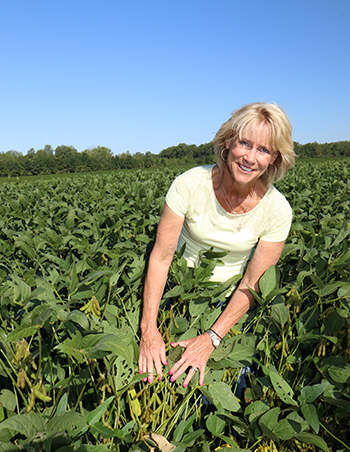Pollinator Placement Could Boost Soybean Yields

Soybean farmers could soon be a-buzz about a new way to improve their bottom line, thanks to a pollinator research project with test plots at Dee River Ranch in Pickens County.
The project, organized by Silicon Valley-based company BeeHero, placed 1.2 million honeybees near fields during the pivotal pollination period. The goal was to increase pod production, which farmer Annie Dee said is an exciting objective.
“Using pollinators could raise soybean yields and, depending on the cost, improve our bottom line,” said Dee, who serves on the United Soybean Board. “It would make us more financially sustainable with just a little more input — and with help from the bees.”
Twenty-four hives outfitted with BeeHero sensors made Dee River Ranch their home in late June, when the soybeans started to bloom.
When BeeHero co-founder Itai Kanot visited the farm to remove the hives in early August, he said the increase in pods was incredible. Bee-pollinated soybean plants had four to five pods at each node; non-BeeHero-pollinated plants had more conventional three pods.
“By bringing in the bees to help pollinate, you’re maximizing the fertilization process,” Kanot said. “You have another helper to go around the flowers and make sure they’re all being pollinated.”
BeeHero sensors collect data to provide accurate insight into hive health. Kanot said it was a natural fit to combine his passion for technology and beekeeping (his father is Israel’s biggest beekeeper).
“This way, we can point the beekeeper to treating his hives more efficiently at just the right time,” Kanot said. “We can get better, healthier bees that are more potent in terms of pollination abilities.”
Studies show bees pollinate over one-third of plants in the American diet. Kanot and BeeHero partners Omer Davidi and Michal Roizman began using BeeHero sensors with crops requiring outside pollination, such as almonds, apples, blueberries and cherries. They’re now cultivating greater pollination percentages in self-pollinating crops like soybeans.
When researching soybean farmers for the trials, Kanot said Dee’s name persistently popped up on Google. He connected with the farm and Dee through Facebook earlier this year.
“Annie is very progressive in her approach to farming,” he said. “Working with her was great. She understands the importance of pollination.”
After this growing season, Kanot’s team will analyze results from Dee River Ranch, in addition to trials in Mississippi soybeans and Minnesota sunflowers. By connecting farmers and beekeepers, Kanot said their goal is to help efficiently feed the world’s growing population.
“We want to help farmers and beekeepers produce more food with less land,” he said. “Getting more output from each acre is key.”
